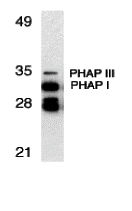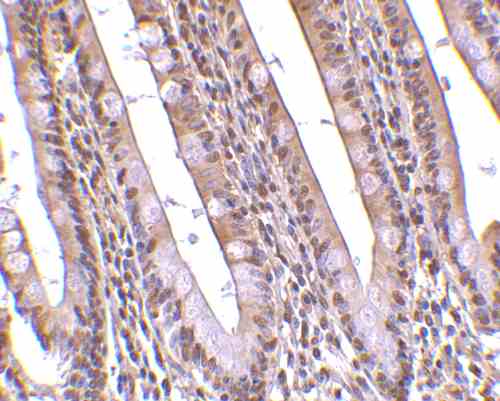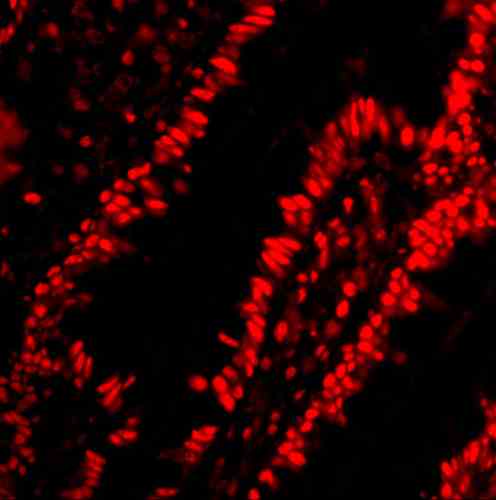| Weight | 1 lbs |
|---|---|
| Dimensions | 9 × 5 × 2 in |
| host | rabbit |
| isotype | IgG |
| clonality | polyclonal |
| concentration | 1 mg/mL |
| applications | ICC/IF, WB |
| reactivity | PHAP (CT) |
| available sizes | 100 µg |
rabbit anti-PHAP (CT) polyclonal antibody 6885
$445.00
Antibody summary
- Rabbit polyclonal to PHAP (CT)
- Suitable for: ELISA,WB,IHC-P,IF
- Isotype: IgG
- 100 µg
rabbit anti-PHAP (CT) polyclonal antibody 6885
| antibody |
|---|
| Tested applications WB,IHC,IHC,ICC/IF,ELISA |
| Recommended dilutions Western Blot: Use at 1ug/ml. Positive control: Raji cell lysate Immunohistochemistry: use at 10ug/ml. These are recommended concentrations. Enduser should determine optimal concentrations for their applications. |
| Immunogen Synthetic peptide corresponding to amino acids near the carboxy terminus of human PHAP (accession no. P39687). |
| Size and concentration 100µg and lot specific |
| Form liquid |
| Storage Instructions This antibody is stable for at least one (1) year at -20°C. Avoid multiple freeze-thaw cycles. |
| Storage buffer PBS, pH 7.4. |
| Purity peptide affinity purification |
| Clonality polyclonal |
| Isotype IgG |
| Compatible secondaries goat anti-rabbit IgG, H&L chain specific, peroxidase conjugated, conjugated polyclonal antibody 9512 goat anti-rabbit IgG, H&L chain specific, biotin conjugated polyclonal antibody 2079 goat anti-rabbit IgG, H&L chain specific, FITC conjugated polyclonal antibody 7863 goat anti-rabbit IgG, H&L chain specific, Cross Absorbed polyclonal antibody 2371 goat anti-rabbit IgG, H&L chain specific, biotin conjugated polyclonal antibody, crossabsorbed 1715 goat anti-rabbit IgG, H&L chain specific, FITC conjugated polyclonal antibody, crossabsorbed 1720 |
| Isotype control Rabbit polyclonal - Isotype Control |
| target relevance |
|---|
| Protein names Acidic leucine-rich nuclear phosphoprotein 32 family member A (Acidic nuclear phosphoprotein pp32) (pp32) (Leucine-rich acidic nuclear protein) (LANP) (Mapmodulin) (Potent heat-stable protein phosphatase 2A inhibitor I1PP2A) (Putative HLA-DR-associated protein I) (PHAPI) |
| Gene names ANP32A,ANP32A C15orf1 LANP MAPM PHAP1 |
| Protein family ANP32 family |
| Mass 28585Da |
| Function FUNCTION: Multifunctional protein that is involved in the regulation of many processes including tumor suppression, apoptosis, cell cycle progression or transcription (PubMed:10400610, PubMed:11360199, PubMed:16341127, PubMed:18439902). Promotes apoptosis by favouring the activation of caspase-9/CASP9 and allowing apoptosome formation (PubMed:18439902). In addition, plays a role in the modulation of histone acetylation and transcription as part of the INHAT (inhibitor of histone acetyltransferases) complex. Inhibits the histone-acetyltranferase activity of EP300/CREBBP (CREB-binding protein) and EP300/CREBBP-associated factor by histone masking (PubMed:11830591). Preferentially binds to unmodified histone H3 and sterically inhibiting its acetylation and phosphorylation leading to cell growth inhibition (PubMed:16341127). Participates in other biochemical processes such as regulation of mRNA nuclear-to-cytoplasmic translocation and stability by its association with ELAVL1 (Hu-antigen R) (PubMed:18180367). Plays a role in E4F1-mediated transcriptional repression as well as inhibition of protein phosphatase 2A (PubMed:15642345, PubMed:17557114). {ECO:0000269|PubMed:10400610, ECO:0000269|PubMed:11360199, ECO:0000269|PubMed:11830591, ECO:0000269|PubMed:15642345, ECO:0000269|PubMed:16341127, ECO:0000269|PubMed:17557114, ECO:0000269|PubMed:18180367, ECO:0000269|PubMed:18439902}.; FUNCTION: (Microbial infection) Plays an essential role in influenza A, B and C viral genome replication (PubMed:30666459, PubMed:32694517, PubMed:33045004, PubMed:33208942). Mechanistically, mediates the assembly of the viral replicase asymmetric dimers composed of PB1, PB2 and PA via its N-terminal region (PubMed:33208942). Also plays an essential role in foamy virus mRNA export from the nucleus (PubMed:21159877). {ECO:0000269|PubMed:21159877, ECO:0000269|PubMed:30666459, ECO:0000269|PubMed:32694517, ECO:0000269|PubMed:33045004, ECO:0000269|PubMed:33208942}. |
| Subellular location SUBCELLULAR LOCATION: Nucleus {ECO:0000269|PubMed:11830591, ECO:0000269|PubMed:18180367}. Cytoplasm {ECO:0000269|PubMed:18180367}. Endoplasmic reticulum. Note=Translocates to the cytoplasm during the process of neuritogenesis (By similarity). Shuttles between nucleus and cytoplasm. {ECO:0000250, ECO:0000269|PubMed:18180367}. |
| Tissues TISSUE SPECIFICITY: Expressed in all tissues tested. Highly expressed in kidney and skeletal muscle, moderate levels of expression in brain, placenta and pancreas, and weakly expressed in lung. Found in all regions of the brain examined (amygdala, caudate nucleus, corpus callosum, hippocampus and thalamus), with highest levels in amygdala. {ECO:0000269|PubMed:15642345}. |
| Structure SUBUNIT: Component of the SET complex, composed of at least ANP32A, APEX1, HMGB2, NME1, SET and TREX1. Directly interacts with SET. Interacts with ATXN1/SCA1. Interacts with MAP1B. Interacts with ELAVL1. Part of the INHAT (inhibitor of histone acetyltransferases) complex. Interacts with E4F1. {ECO:0000269|PubMed:11163245, ECO:0000269|PubMed:11555662, ECO:0000269|PubMed:11729309, ECO:0000269|PubMed:12628186, ECO:0000269|PubMed:16818237, ECO:0000269|PubMed:17557114, ECO:0000269|PubMed:18180367}.; SUBUNIT: (Microbial infection) Interacts (via C-terminus) with influenza virus A protein PB2; this interaction promotes viral replication. {ECO:0000269|PubMed:30666459}.; SUBUNIT: (Microbial infection) Interacts (via C-terminus) with influenza virus B protein PB2; this interaction promotes viral replication. {ECO:0000269|PubMed:33045004}.; SUBUNIT: (Microbial infection) Interacts (via C-terminus) with influenza virus C protein PB2; this interaction promotes viral replication by bridging viral replicase dimers together. {ECO:0000269|PubMed:33208942}. |
| Post-translational modification PTM: Phosphorylated on serine residues, at least in part by casein kinase 2/CK2. {ECO:0000269|PubMed:15287743}.; PTM: The N-terminus is blocked.; PTM: Some glutamate residues are glycylated by TTLL8. This modification occurs exclusively on glutamate residues and results in a glycine chain on the gamma-carboxyl group (By similarity). {ECO:0000250}. |
| Target Relevance information above includes information from UniProt accession: P39687 |
| The UniProt Consortium |
Data
Publications
| pmid | title | authors | citation |
|---|---|---|---|
| We haven't added any publications to our database yet. | |||
Protocols
| relevant to this product |
|---|
| Western blot IHC ICC |
Documents
| # | SDS | Certificate | |
|---|---|---|---|
| Please enter your product and batch number here to retrieve product datasheet, SDS, and QC information. | |||
Only logged in customers who have purchased this product may leave a review.













Reviews
There are no reviews yet.